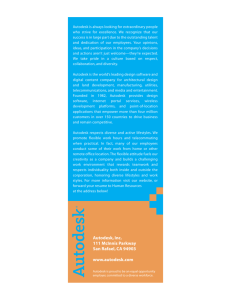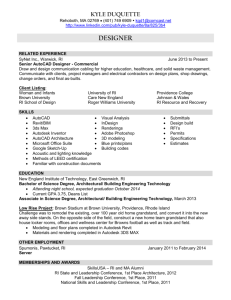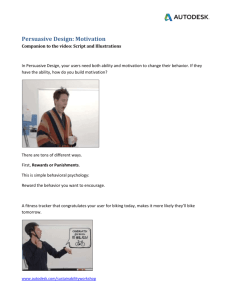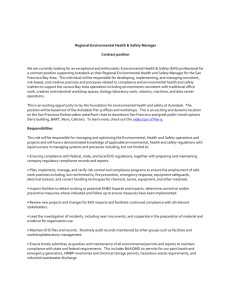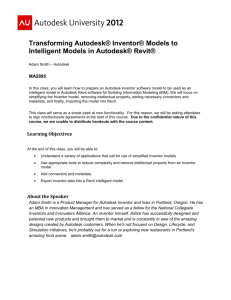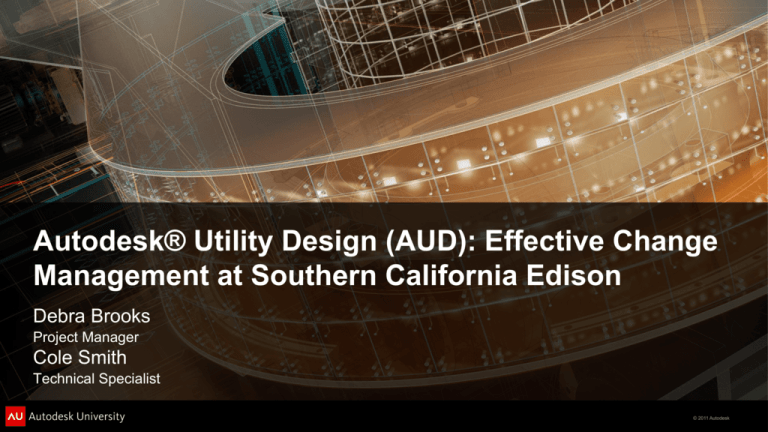
Autodesk® Utility Design (AUD): Effective Change
Management at Southern California Edison
Debra Brooks
Project Manager
Cole Smith
Technical Specialist
© 2011 Autodesk
Class Summary
This class will take you through the challenges and opportunities of change
management from a utility perspective, including a discussion of SCE’s:
Technical solution which integrates SAP and Bolt-On applications
Process to leverage AUD as the center of the graphical designing and
engineering
Challenges faced when creating significant culture change
© 2011 Autodesk
Learning Objectives
At the end of this class, you will be able to:
Understand SCE’s approach to change management
Engage key personnel with the correct activities
Identify areas where technology impacts organizational culture
Apply lessons learned from SCE's AUD Implementation
© 2011 Autodesk
Southern California Edison
One of the Largest U.S. Electric Utilities
180 cities in 50,000 square-miles of service territory
Nearly 14 Million People Served
Renewable energy Met 19.4% of our Customers’
Energy Needs in 2010
3,000,000+ smart meters installed as of September
2011
Delivering Service Takes
16 utility interconnections
4,990 transmission and distribution circuits
365 transmission and distribution crews
Over 15,500 TDBU employees
© 2011 Autodesk
A Tale of Two Electric Companies
Full-Screen Layout
Image Size (1,920 x 1,000 pixels)
© 2011 Autodesk
Work Orders
© 2011 Autodesk
Design
© 2011 Autodesk
Scheduling
© 2011 Autodesk
Work
© 2011 Autodesk
Other Business Drivers
EIX Capital Projects
Smart Connect
Customer
Expectations
© 2011 Autodesk
Ok – we need to change….but how?
© 2011 Autodesk
Key Factors to Drive Successful Change
Articulate the case for change throughout all levels of the organization
Establish a clear vision, and always maintain alignment
Utilize process mapping to identify change impacts: As-Is/To-Be
Engage the stakeholders and end users early on and frequently
Manage scope and align expectations
Communication, Communication, Communication!
Drive down communication to all levels
Communication the right level of information to the right target audience
© 2011 Autodesk
Driving Change - High Level Approach
Blueprint
Realization
•Process & Technical Mapping
& validate with business
Define End-State Vision
•Define major impacts
•Validate impacts with
business areas
Identify business
impacts
•Identify potential options
•Identify pros and cons
•Validate options with
business areas
Identify options for each
business area
The solution was arrived at
using input from:
•Key Operational Areas
• Distribution
• Transmission
• Substations
• Finance
• Supply Chain
•BP&TI
•Executive Leadership
•Propose Option
•Review and approve
with business
Propose
Options
Execute Deliverables
•Interfaces & Systems
•Business process
changes
•Testing and training
© 2011 Autodesk
Vision: IPSEC Work Management Model
1. Initiate
Actions to document the need to perform work
Customer Service, Design Manager, SAP
2. Plan
3. Schedule
2. Plan
Actions to establish accounting, resources and
work instructions
Design Manager, Autodesk Utility Design
4. Execute
3. Schedule
IPSEC
Committing resources to perform required work
Click Schedule
4. Execute
Perform work and report completion
Mobile Field Tool
5. Close
Actions to update status, asset and equipment
records and finalize accounting
SAP
1. Initiate
5. Close
© 2011 Autodesk
End State Vision – System & Process Alignment
Internal / External Customers
eMobile
SAP
CSS
SCE’s
DM
Integrated
Design
Process
SCE’s
DM
Order
Design
AUD
GIS
SAP
Optimized
Mobile
Scheduling
Ruggedized Close &
Software
Notebooks Feedback
Click
Soft
CU
Plan
SAP
CMS
S A P
Initiate
eMobile
Schedule
Execute
Close
In-Flight
© 2011 Autodesk
End State Vision: Technical Architecture
SAP is now at the
core of our
operations
Through our ERP
Blue Print, SAP
integrates with our
Bolt-On Systems to
create end-to-end
solutions
Mobile
Field Tool
Telecomm
Bolt-On
Systems
Scheduling/
Forecast
SCE’s DM
AUD
SAP
Project
Payroll /
Finance
Systems
HR
Work
Mgmt
Customer
Service
System
Total of
16
Different
(nonSAP)
Systems
Portal
Supplier,
Reporting
Services
BI
Mgmt
Finance
Outage
Mgmt
System
Mapping
Fixed Asset Accounting
© 2011 Autodesk
A Phased Business Engagement Approach
User Experience will provide an opportunity to strategically transfer solution
knowledge to the Business during the various stages of the project
Business
Business
Line
Partners &
ERP
Super
Business
Project
Users
Line
Team
Advisors
Blueprint
Build & Realization
Business
Line Key
Employees
Business
Line
Employees
Deployment & Go-Live
Solution Understanding/Ownership
© 2011 Autodesk
Stakeholder Roles & Responsibilities
Business
Area
Business
Director
Distribution
Communicate
Construction & key messages
Maintenance
and issues
Business
Advisor
ERP Team
Member
Business
Partner
Super User
Provide
business
knowledge,
insight, and
influence to
assure User
Engagement is
successful
Assure the
business has
early
engagement
and ownership
of the new
systems
Key
representative
from DC&M
with the
knowledge and
skills to support
the testing,
training, and
implementation
Core group of
employees
across TDBU.
Will be fully
functional and
prepared to
conduct our
day-to-day
business
Henry Ford
John Delorean
John Smith…
Distribution
Thomas Edison Nick Tesla
Construction &
Maintenance
© 2011 Autodesk
GDT Project Vision & Objectives
Vision
Deliver an integrated design solution across Transmission, Distribution &
Substation by combining asset and compatible unit information with tabular
and graphical design capabilities
Objectives & Benefits
• Improve planner productivity through engineering automation
• Enable material and crew efficiencies through standardized work order
designs
• Minimize re-mapping efforts during work order reconciliation (e.g. quicker
reflection of as-built information on the FIMs)
• Link engineering and construction standards to the design process,
improving consistency and accuracy in design
• Long term architecture to include a comprehensive GIS
© 2011 Autodesk
AUD - Project Timeline
April 2007:
Contract Awarded
to Autodesk
2007
April – Sept 2007:
Requirements
Gathering
Oct 2007 –
Nov 2010:
Development
2008
Jan 2009:
Deployment to
Distribution
2009
Sep 2008 – Dec 2010:
Testing
Nov 2010:
2012 and beyond:
Deployment to
Transmission
Continuous
Improvements
2010
May 2010:
Integration with
SAP
2011
2012
June - Dec 2011:
Development and
Implementation of
U.I. Project
© 2011 Autodesk
Process Blueprinting: To-Be
© 2011 Autodesk
Impact Assessment
High - Use new transaction; extensive training
required; critical activity; significant down-stream
impact to workforce.
Medium – Viewing new transaction; medium
training required; moderate downstream impact;
involves a moderate number of employees.
Low – Optimizing capabilities; minimal training;
few employees impacted; non-critical transaction.
© 2011 Autodesk
Change Impacts of AUD
From/To
1. Visio / AUD will be standard
product for work order designs
2. Excel / AUD engineering
approved functionality
3. DPIS/Design Manager (DM)
4. Inability to / Ability to import
Customer drawings and FIM
Impact
Benefits/Change Impacts
H
H
Adherence to design standards /Planners/Designers
will be required to utilize DM / AUD for all designs.
AUD will have automated material capabilities via
design.
H
H
Consistent calculations / AUD Integrates engineering
capabilities (voltage drop, wind loading and cable
pulling) with a CAD based system design.
H
H
DM will allow search/retrieve data, equipment
records, TLM and structures. Does not exclude
access to Google Earth for additional information.
H
H
Less time creating maps. FIM drawings filed centrally
and auto converted for quicker FIM updates from
actual construction.
© 2011 Autodesk
The Future of One Electric Company
© 2011 Autodesk
Demand Driven
© 2011 Autodesk
Work Orders
© 2011 Autodesk
Design
© 2011 Autodesk
Scheduling
© 2011 Autodesk
Some Things Do Not Change
© 2011 Autodesk
Lesson Learned
You really don’t know your business processes until you go through the pain
and effort of mapping
T&D is a complex set of businesses that requires a complex technology solution
Strong leadership is necessary to drive the solution home:
Early, frequent, and intense engagement at all levels
Highly targeted readiness and communications efforts
Phase implementation of technology, process changes, or both
Establish clear utilization expectations & continue to sustain change post
stabilization
Identify metrics early on and ensure supporting data will be available
Acknowledge that productivity dips are a natural part of the process
Culture change is much more difficult than technical change
© 2011 Autodesk
Questions?
© 2011 Autodesk
Autodesk, AutoCAD* [*if/when mentioned in the pertinent material, followed by an alphabetical list of all other trademarks mentioned in the material] are registered trademarks or trademarks of Autodesk, Inc., and/or its subsidiaries and/or affiliates in the USA and/or other countries. All other brand names, product names, or trademarks belong to their respective holders. Autodesk reserves the right to alter product and
services offerings, and specifications and pricing at any time without notice, and is not responsible for typographical or graphical errors that may appear in this document. © 2011 Autodesk, Inc. All rights reserved.
© 2011 Autodesk

